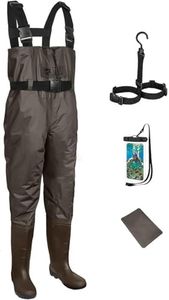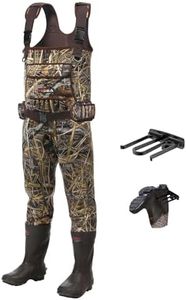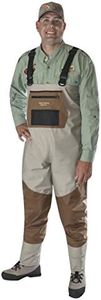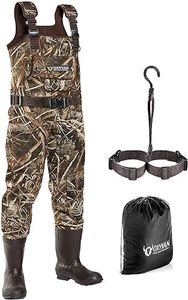We Use CookiesWe use cookies to enhance the security, performance,
functionality and for analytical and promotional activities. By continuing to browse this site you
are agreeing to our privacy policy
10 Best Fishing Waders
From leading brands and best sellers available on the web.By clicking on a link to a third party's website, log data is shared with that third party.
Buying Guide for the Best Fishing Waders
Choosing the right fishing waders can really improve your comfort and effectiveness while fishing. Waders keep you dry and warm, letting you venture into streams, rivers, or lakes where fish might be just out of reach from the shore. The key to picking the best waders is to match their characteristics to the conditions you’ll face and your style of fishing. Understanding the main specifications will help you get a pair that fits well and performs reliably.MaterialThe material of fishing waders is important because it affects both their durability and comfort. The common materials are neoprene, breathable fabrics, and rubber. Neoprene waders are warmer and better for cold water, while breathable waders are lighter and more comfortable in warmer conditions. Rubber waders are generally tougher but heavier and not as comfortable for long periods. If you fish in cold weather or stand still in water for hours, neoprene might be best. For warm climates or active movement, breathable materials help you avoid sweating.
Wader StyleWader style refers to how high the waders come up your body, and this affects how deep you can go and how comfortable you'll be. Hip waders come up to your hips and are good for shallow streams or marshlands. Waist-high waders are like waterproof pants and offer a bit more coverage. Chest waders go up to your chest and give the most protection against deep water, but can feel warmer and bulkier. Think about the typical depth of water you'll be fishing in when choosing the style: for very shallow streams, hip waders might be enough, but for unpredictable water or deeper rivers, chest waders are safer.
Bootfoot vs. StockingfootWaders come as either bootfoot, where the boots are attached, or stockingfoot, where you wear separate wading boots. Bootfoot waders are simpler to put on and take off and are excellent for muddy or marshy ground. Stockingfoot waders are more versatile, fitting closely around your ankle and allowing you to pick wading boots that fit you and the terrain best. If you need maximum convenience, especially in cold or muddy conditions, go for bootfoot. If you want the best support and traction, especially if you walk a lot or fish on slippery rocks, stockingfoot with separate boots is the way to go.
Seam ConstructionThe seams of your waders are where leaks are most likely to occur. Welded or taped seams last longer and are more leak-resistant, while stitched seams may eventually let in water but can be more flexible. If you plan to use waders often or in rough environments, go for reinforced seams. For occasional use in calm, shallow water, standard seams might do the job. Always check how the manufacturer recommends maintaining the seams to extend their life.
Fit and SizeGetting the right fit matters for comfort and movement. Waders that are too tight can restrict your movement and be uncomfortable, while those that are too loose may let in water or get snagged. Sizing varies, so always check the sizing charts, try them on if you can, and make sure you can kneel, squat, and walk comfortably. Consider the clothes you'll wear underneath (like thermal layers for cold water) when choosing the size. The right fit keeps you warm, dry, and comfortable during your fishing trips.














